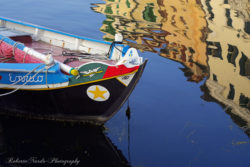
Briccole (in Venetian dialect bricole) are big poles scattered throughout the Venetian Lagoon. In group of three, they indicate the lagoon ways, where the depth of water is enough to be navigable even in case of low tide.
They are also driven at channel side to indicate moorings, which could not be recognisable in case of fog or bad weather and many boats could have problems with shallows, therefore they could be beached and unable to move.
At channels intersection there is the “dama”, a cluster of piles, where in the middle a higher pole is driven. Usually the highest pole has got a little beacon and if necessary a sign for the maximum allowed speed in the channels.
The Venetian Lagoon was soon an important crossing of commercial, river and sea itineraries, a trade and travel hub between the East and Northern Europe.
Since then briccole were used by sailors to find their bearings and get information about the lagoon area, like depth and tide alternation.
Even now these lagoon poles are essential to navigation regulation and act as a real road system, showing the navigable channels and itineraries, as well as being used as moorings.
The name “briccole” has an uncertain origin, but it seems to derive from breeze. Breeze, wind along with the primordial cycle of Water and Earth, determine tide alternation and the mix of fresh water and salt water and make this heritage unique in the world.

Bragozzo is one of the most well-known symbol of Chioggia. It is a traditional boat, designed in Chioggia around the 18th century, and replaced by the modern fishing boats in the 1960s. The Bragozzo was created for lagoon fishing, but later on it was adapted to sea fishing.
It is characterized by its round prow, its squat stern and its flat bottom. It is 15-metre-long and its hull is usually decorated with religious symbols. The trapezoidal sails (vele al terzo) were decorated too and were made by the fishermen and their housewives. These sails were very colourful and personalized to recognize every boat from afar. Above the mainmast there was the penèlo, the old weather vane, a wooden openwork. The penèlo was made up by three panels: the lower part depicted the Patron Saints Felice and Fortunato, the middle part depicted Jesus Christ’s Passion symbols (the Cross, the Ladder, the Spear, the Cock on the column, the Sponge on a reed…), and finally the upper part depict two birds called “fenisse”, the phoenix (the legendary bird that rises from its ashes), and two circles, sun symbols. The penèlo protects and braves sea dangers.
Bragozzi and other ships were built inside the town shipyards, called squeri. These small shipyards were managed by shipwright masters, that handed down the craftsmanship from one generation to another. The first building stages took place behind closed doors in a building called ténza. When the ship was ready it was launched with celebrations and blessings.
Ships were made of wood suitable for water, like oak or durmast, small boats bottom was made of larch or fir. Masts were made of pinewood and oars were made of beechwood. Shipwright masters decided the thickness and the size of the wooden boards and craftsmen carried out.
In 1867 there were 41 squeri in Chioggia. Nowadays there are only about 10.


